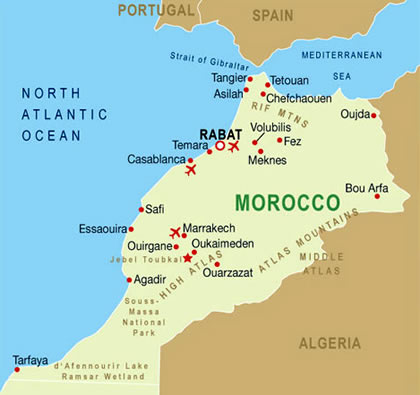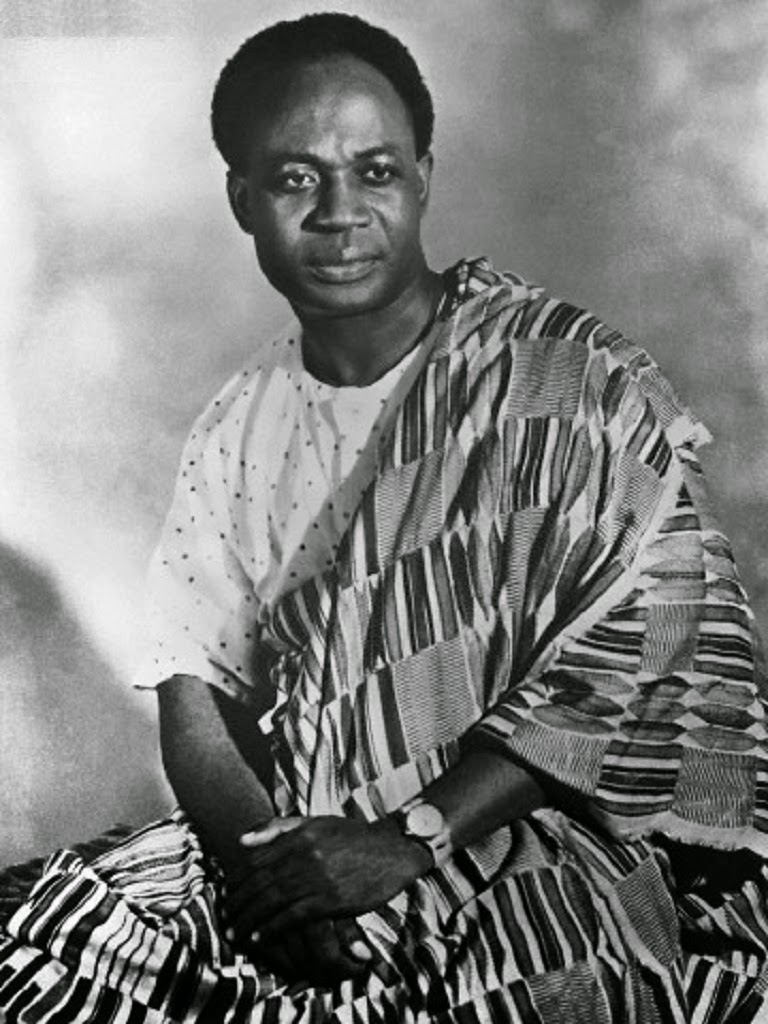 |
| Map of Nigeria |
Nigeria is located in western Africa on the Gulf of Guinea between Benin and Cameroon. It occupies 923,768 square kilometers (356,667 square miles), making it one-third larger than the U.S. state of Texas. Nigeria stretches 1,600 kilometers (1,000 miles) from north to south, and is 1,100 kilometers (700 miles) wide from the
Atlantic coast to its eastern border.
Nigeria’s population has grown extremely rapidly from 35 million to over 137 million in 2004. It is home to one out of every six Africans. The population is extremely diverse and contains as many as 250 separate ethnic groups and a reported 500 languages.
The major population divisions include the Hausa (29 percent), who live in the north; the Yoruba (21 percent), who occupy the southwest; the Igbo or Ibo (18 percent), who are in the southeast; and the Ijaw (10 percent), who reside in the east.
The Fulani (9 percent), found primarily in the north, along with a large number of smaller groups, complete the essential Nigerian ethnic matrix. This societal complexity makes for enormous governing difficulties.
There is also the divide of religion, with the north heavily Muslim and the south largely Christian. One attempt to foster better unity was the adoption of English as the nation’s official language. Fifty percent of the population now has a basic command, although there are many more who speak a smattering of broken or “pidgin” English.
Administratively the nation is currently divided into 36 states and one capital territory. Abuja, located in the center of the country, became the nation’s capital in 1991, replacing in this capacity the large port city of Lagos with its over 13 million people.
 |
| National Mosque in the capital Abuja |
Modern Nigeria is a product of the late 19th-century British Empire builders. Before this time it was part of a wide-ranging section of West Africa made up of many peoples and territories, all occupying much smaller tribal areas. Lagos became a full British colony in 1861.
The country’s name is taken from the river Niger. The actual official designation of Nigeria is often attributed to the wife of a colonial official who in 1898 merged Niger with “ia” to create today’s identity, which means literally “black area.”
All of West Africa, including Nigeria, was the subject of even earlier European interest. The
Portuguese came to the area in the late 15th century, attracted by the lucrative slave trade with local tribes.
The profits were such that the Portuguese slave trading monopoly was broken in the 16th century as other Europeans, including the British, wanted a share of the riches. Lagos and Badagry became important markets for the exchange of a variety of products, particularly gin and firearms.
Although the
slave trade was abolished in the British Empire and in the United States after 1807, British commercial interest in the area didn’t decline, and the penetration of the interior rivers by steamships began in earnest after the 1840s.
Lagos became a key base and, in 1886, the National African Company, later the Royal Niger Company, received a royal charter to oversee trade in the Niger Delta, which included governing rights. The company’s interests also expanded northward.
These operations became too expensive and, in 1897, the company’s governing provisions were removed, and the British government asserted its authority, creating in 1900 a North Nigeria Protectorate. By 1902 after a time of armed resistance, the Sokoto Caliphate and Kano submitted to British authority.
 |
| Frederick Lugard, Governor-General of Nigeria (1914–1919) |
Lugard, who had become governor-general, now combined all the protectorates with Lagos to form, in January 1914, the Federation of Nigeria. A policy of indirect rule followed during which local tribal leaders, emirs, and sultans administered their areas in conjunction with the colonial civil service.
As late as the 1930s only a few hundred British officers were in country. Infrastructure was improved, including railroad construction to the north, but education in the Muslim areas lagged behind Christian-led efforts in the south. The north remained essentially a distinct enclave.
Nationalism became an increasing factor during the 1930s and was essentially motivated by the notion of Pan-Africanism. Yet a Nigerian sense of nationalism was made more difficult by the area’s many regional and tribal divides.
The end of
World War II left Britain weary of the demands and costs of empire, and moves toward change occurred as early as 1946. At this time a constitutional reform was introduced that created in the first instance three regional legislatures. A fourth midwest regional legislature was added in 1963. Full self-government came to these regions in the 1950s.
The desired goal was the formation of a federal legislative structure for all of Nigeria, a system that the north finally agreed to join in 1959. Direct elections occurred in 1959, and a federal government was founded. This new government, meeting for the first time in 1960, declared Nigeria’s independence on October 1.
 |
Princess Alexandra opens the newly independent Nigerian Federal Parliament
in Lagos on 3 October 1960 |
This sense of national hope proved short-lived. Old antagonisms emerged and threatened any idea of lasting unity. The conflicts came quickly with the Yoruba opposing western regional reorganizations.
This lack of stability undermined the national government, creating a pattern for the future that would include ethnic fighting and massive corruption. In 1963 Nigeria became a federal republic with an elected president in an effort to strengthen central authority. The elections in 1964 produced more arguments and rioting over suspected electoral fraud.
The Nigerian National Alliance took control of parliament, and the United Progressive Grand Alliance of eastern and western groups became their main opposition. This unsettled situation led eastern Igbo-dominated army officers to stage a coup in January 1966.
Major General Johnson Aguiyi-Ironsi took command and instituted bloody purges of the political establishment. Fighting broke out within the army itself. After only four months in charge General Ironsi was dead, and Yakubu Gowon, a lieutenant colonel soon to be general, had taken over as leader of the military government.
The situation failed to settle, particularly after the Hausa murdered approximately 20,000 Igbo who lived in the north. Retaliations led to more discord, motivating the eastern region’s military governor, Lieutenant Colonel Odemugwu Ojukwu, to declare on May 30, 1967, the eastern region an independent entity called the Republic of
Biafra.
 |
| Lieutenant Colonel Odemugwu Ojukwu |
This situation led to a bloody civil war, perhaps the worst in modern African history. The war lasted three years and cost numerous lives. At war’s end the victorious Federal side declared a period of reconciliation and launched a campaign to reconstruct the devastated area.
Nigeria was now firmly in the hands of Gowon’s Supreme Military Council, which did promise a return to civilian rule in 1976. Efforts were made to transform the economy from its agricultural base to a more modern mixed economy. There were serious attacks on corruption and moves to control the government’s role in the expanding oil industry, which from the late 1960s saw Nigeria become one of the world’s largest exporters.
Criticism of Gowon’s rule was steadily mounting. While attending a 1975 Organization of African Unity conference, Gowan found himself the victim of another coup led by the Sandhurst-trained brigadier general Murtala Mohammed.
General Mohammed consolidated his authority, purged government offices, created more administrative states, and put military governors in control of the media. He also imported new Soviet aircraft for the military. His time in office, though, proved short-lived.
He was assassinated by fellow officers in 1976. His replacement was General Olusegun Obasanjo, a Yoruba, who would years later become Nigeria’s president. In 1979 Obasanjo produced a new constitution based on the U.S. model and prepared for elections to return the country to civilian rule.
The fall in
oil prices in 1981 brought problems for the new government as debts mounted. The result was a poor business climate. Blame was projected onto many quarters, violence was frequent, and foreign workers were expelled. The unrest also brought an end to the Shehu Shagari presidency, which again saw a disgruntled military react, cancelling Shagari’s 1983 election.
Mohammed Buhari, the chief of the army, took over the government with the standard promises to end corruption and reverse the fortunes of the state. However, Buhari didn’t last long, and in August 1985 he was overthrown by General Ibrahim Babangida. General Sani Abacha gave his support to this coup, and in 1990 he positioned himself for later rule when he became minister of defense.
 |
| General Sani Abacha, 10th President of Nigeria |
Army control did not reverse the economic crisis, which was now dire. Currency devaluation was demanded as a term for continued
International Monetary Fund (IMF) and
World Bank financial support in the form of loans. Again a return to civilian rule was planned, and state elections were scheduled for 1991, with a presidential election to follow in 1993.
To the military’s surprise, Moshood Abiola won. The military, however, rejected the result, Babangida imprisoned Abiola, and in the midst of continuing confusion General Sani Abacha took over as military president.






















